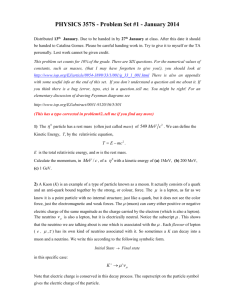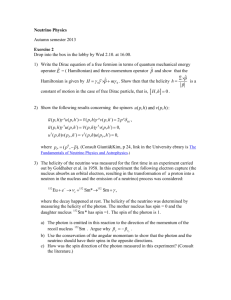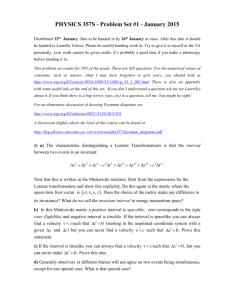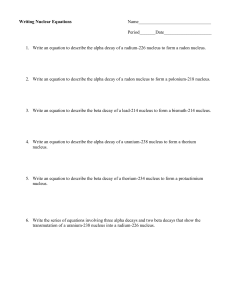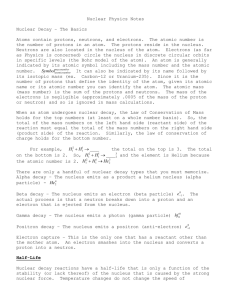PROBset1_2016 - University of Toronto, Particle Physics and
advertisement
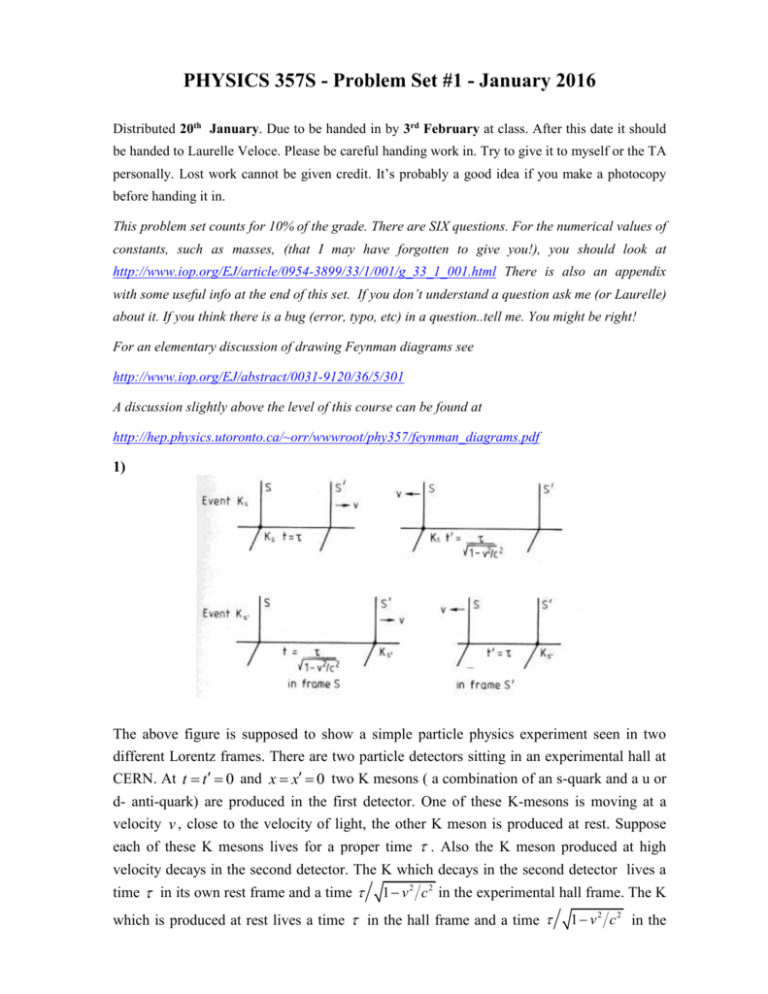
PHYSICS 357S - Problem Set #1 - January 2016 Distributed 20th January. Due to be handed in by 3rd February at class. After this date it should be handed to Laurelle Veloce. Please be careful handing work in. Try to give it to myself or the TA personally. Lost work cannot be given credit. It’s probably a good idea if you make a photocopy before handing it in. This problem set counts for 10% of the grade. There are SIX questions. For the numerical values of constants, such as masses, (that I may have forgotten to give you!), you should look at http://www.iop.org/EJ/article/0954-3899/33/1/001/g_33_1_001.html There is also an appendix with some useful info at the end of this set. If you don’t understand a question ask me (or Laurelle) about it. If you think there is a bug (error, typo, etc) in a question..tell me. You might be right! For an elementary discussion of drawing Feynman diagrams see http://www.iop.org/EJ/abstract/0031-9120/36/5/301 A discussion slightly above the level of this course can be found at http://hep.physics.utoronto.ca/~orr/wwwroot/phy357/feynman_diagrams.pdf 1) The above figure is supposed to show a simple particle physics experiment seen in two different Lorentz frames. There are two particle detectors sitting in an experimental hall at CERN. At t t 0 and x x 0 two K mesons ( a combination of an s-quark and a u or d- anti-quark) are produced in the first detector. One of these K-mesons is moving at a velocity v , close to the velocity of light, the other K meson is produced at rest. Suppose each of these K mesons lives for a proper time . Also the K meson produced at high velocity decays in the second detector. The K which decays in the second detector lives a time in its own rest frame and a time 1 v 2 c 2 in the experimental hall frame. The K which is produced at rest lives a time in the hall frame and a time 1 v 2 c 2 in the rest frame of the high velocity K. Thus the time ordering of the two events K S and K S ' depicted above are reversed. a) Why is this not a problem? b) Show explicitly that K S and K S ' are separated by a space-like interval. 2) Neutrino physics is a very active subject. Some people hope that the behavior of neutrinos will explain why the universe does not have the same amount of matter and antimatter. You might ask how we can produce beams of neutrinos at an accelerator. We can produce them in the following decays of and K mesons (which are bound states of quarks and anti-quarks). K . The are the neutrinos. Say we fire a beam of 1015 per second and 1015 K per second into an evacuated tunnel 800 meters long. Assume that the beam has a momentum of 400 GeV c The rest mass of the is 0.14GeV c2 , and the mean lifetime is 2.6 108 s . The rest mass of the K is 0.494GeV c2 , and the mean lifetime is 1.2 108 s . How many neutrinos per second do we get at the end of the tunnel? 3) The Kamiokande experiment in Japan, and the SNO experiment in Sudbury Ontario, were the first to show definitively that neutrinos have mass. Before that we only had upper bounds on neutrino mass. For example, the limit on the mass of the e came from tritium beta decay (you can do an experiment in the advanced undergraduate lab using the Ge detector to put your own limit on the mass). This gave a limit of around m e 30 eV . In February 1987, a UofT graduate student discovered the supernova SN1987A in the Large Magellenic Cloud. A few hours before the first sighting a burst of neutrino interactions were observed in the Kamioka and IMB neutrino detectors. These interactions were due to e . The neutrino interactions covered the range 10 40MeV and the interactions seem to have been spread over about 10 seconds in time. Use these facts to estimate an upper limit on the mass of the e . Assume that the distance to SN1987A is 1.5 105 light years. What was the name of the famous UofT graduate student? Remember your special relativity. The velocity of a particle of a given energy depends on its mass. 2 4) In the figure above, two particles with 4-momenta pA and pB undergo some interaction in the blob. It could be electromagnetic, strong, weak, or something we have never thought of. The nature of this interaction is the dynamics of this interaction. Whatever the nature of this interaction, the kinematics is the same. That is, for example, the values of the outgoing 4-momenta pC and p D will be constrained by 4-momentum conservation. Also there will be various Lorentz invariant combinations of the 4-momenta. One set of invariants often used is: s p A pB t p A pC 2 2 u p A pD 2 a) Why do I know that these are Lorentz invariant? Now imagine an elastic scattering event between two particles having the same mass m and in the CM frame they have 3-momentum p . After this interaction the particles have the same p , that’s what we mean by elastic, and they have scattered through an angle in the CM frame. Just to clarify your thoughts sketch this interaction in the CM before and after the interaction. Since these are Lorentz invariant quantities, you can calculate them in any frame you like… and believe me, the CM frame is the one to use! b) Show that, for this special case of elastic 2-body scattering, s 4 p 2 m2 t 2 p 2 1 cos u 2 p 2 1 cos Note that I am using c=1, put in the c’s explicitly if you like. These Lorentz invariants are called the Mandelstam Variables. c) Explain why the 4-momentum transfer for what I call a time-like process is negative, and that of a space-like process has to be positive. 3 5) You know that nuclei are made up of protons and neutrons, and that protons have one +ve electron charge, and neutrons are electrically neutral The nucleus of any element is labeled as ZA S . The total number of protons and neutrons is given by A, the mass number of the nucleus. The number of protons in the nucleus is given by Z, the atomic number of the nucleus. The chemical symbol of the nucleus is S. Since Z is also equal to the number of electrons in an atom of this element, it determines the chemical properties of the element. Unstable (radioactive) nuclei often decay to unstable products, which themselves decay. Decay chains also occur for particles An example of a natural decay chain is that leading to Radon gas in the basements of buildings. The chain is 238 92 234 U 90 Th 234 90 234 Th 91 Pa e 234 91 234 Pa 92 U e . 234 92 230 U 90 Th 230 90 226 Th 88 Ra The steps where an e is emitted is known as beta decay. Essentially it corresponds to a proton changing into a neutron in the nucleus by the process n p e e , where the e is an electron neutrino (we’ll learn why that has to be there soon!). The step where an is emitted is known as alpha decay; emission of a helium nucleus. (a) Say we have the decay chain of isotopes N1 N 2 N3 . The expressions for the first two steps in this chain are dN1 1 N1 dt dN 2 1 N1 2 N 2 dt Write down an expression for (1) dN 3 . dt If N3 is stable (remember what stable implies for the decay constant of a particle), show that 4 N1 t N10e 1t N2 t 1 2 1 N10 e 1t e 2t 1 e N3 t 1 2 N10 2 1 1 1t 1 e 2t 2 You can integrate the equations in (1) above easily, if you remember that dN 2 2t d N 2 e2t e 2e2t N 2 , dt dt N 2 (t 0) N 2 (t 0) 0 Consider two cases of these equations: a) 1 2 , t 11 b) 1 2 , t 2 1 In these two cases derive the behaviour of N 2 t . Comment on what they indicate about how N 2 t varies in time…. Especially the second case. Try to explain physically what is happening in the second case. (b) In any situation, the outcome depends on the relative decay rates. However, take has a mean lifetime of 7.2 days, and is a -emitter, giving turn decays by -emission to 206 82 Bi which Po (mean life 200 days), which in Pb (again, look at the number of protons and neutrons). stable. If the source initially only contains maximum? Note: nuclei are labeled as 210 84 210 83 210 83 numer of (protons + neutrons) number of protons 206 82 Pb is Bi , after how long will the rate of -emission be a Chemical Symbol 6) Here are some questions about Feynman diagrams. When you draw them, use the ones I did as examples. Remember to put in little arrows showing the direction of particles and antiparticles, also label each line. Also remember that electric charge is conserved at each vertex of a Feynman diagram. Make sure that you understand what is a virtual particle line, and what is a freely propagating particle line. Virtual lines do not have arrows on them .... why is that? a) Draw all the leading order ( 2 vertices) and next-to-leading order ( 4 vertices) for electron- positron elastic scattering. I count two leading order and ten next-leading order. Remember that all the lines have to be connected; except the ends of the incoming and outgoing particles. 5 b) Elastic scattering between electrons and positrons, e e e e , is known as Bhabha scattering after the Indian physicist of that name. Determine the mass of the virtual photon in Bhabha scattering, assuming that the electron and positron are at rest. What is the velocity of the virtual photon? Is that possible for real photons? c) For e e scattering where the e e beams have finite momentum, there are two Feynman diagrams at lowest order. These correspond to annihilation and elastic scattering. Prove that the virtual photon in one case is timelike, and in the other is spacelike. d) In the introductory lecture I mentioned that the Z 0 was a mediator of the weak interaction. So, it couples weakly to both e , e and to the charged mediators of the weak interaction, W ,W . I also said that the weak and electromagnetic interactions were really the same interaction. That means that a process taking place via virtual photon exchange, can equally well take place through virtual Z 0 exchange. Now, draw all the leading order diagrams contributing to the process e e W W ; assuming that the weak and electromagnetic interactions have equal strength. The Large Electron Positron collider (LEP) at CERN studied this process, as a precision test of the electroweak model. e) Draw the Feynman diagram for pair production, e e and for the process of Bremsstrahlung, which is when an electron radiates a photon, in the field of a heavy nucleus. e e Why do neither of these processes occur in free space, i.e. why do they only occur in the field of a nucleus? Demonstrate this using 4-vector notation Hint: This is really simple if you use 4-vector notation. Write down the total 4-momentum squared for the initial state and the final state, remembering that the photon has zero mass. Do this in the rest frame of the photon. Remember that 4-momentum is conserved, as is 3momentum. 6 Possibly Useful Physical Constants: Avogadro No: 6 1023 mole 1 pi speed of light: 3.1416 c 3.0 108 m s 6.6 1022 MeV s c 197 MeV . fm Plank's constant: c 2 0.4 GeV 2 mb 1 eV 1.6 1019 Joules 1 eV c 2 1.8 1036 kg 1 fm 1015 m 1 mb 1027 cm 2 1 year 1 year 107 s electron charge: electron magnetic moment: e 1.602 1019 C e 9.31024 Joules Tesla1 strong coupling constant: c 1 137.0360 s M Z 0.116 0.005 Fermi coupling constant: Cabibbo angle: GF 1.166 105 GeV 2 sin C 0.22 Weak mixing angle: sin 2 W M Z 0.2319 0.0005 e2 fine structure constant: BR Z e e 3.21 0.07% Branching Ratios BR Z hadrons 71 1% ________________________________________________________________________ 7 Particle Properties Boson gluon Mass GeV c 2 Lepton e W 3 1036 ~0 80.22 Z0 91.187 H0 125 Hadron , 0 , e Mass MeV c 2 Quark Content ud , uu dd 2 , du 139.57,134.97, 139.57 Mass MeV c 2 105 0.510999 0.27 105.658 10 1777 1 0 I J PC K, K us , su 493.65 1 0 2 K 0, K 0 ds , sd 497.67 1 0 2 , 0, ud , uu dd 2 , ud 775.7 1 1 p ,n uud , udd 938.27, 939.57 1 1 2 2 , 0 , , ddd , udd , uud , uuu 1232 3 3 2 2 0 uds 1115.6 1 0 2 D0 , D0 uc , cu 1863 1 0 2 D , D dc , cd 1869 1 0 2 DS , DS cs , cs 1968 B , B ub , ub 5279 c udc 2285 , 0 , uus, uds, dds 1189 1 0 , uss, dss 1315 1 1 2 2 sss 1672 b udb 5624 8 0 0 1 0 2 1 0 2 1 2 3 0 2 1 0 2
